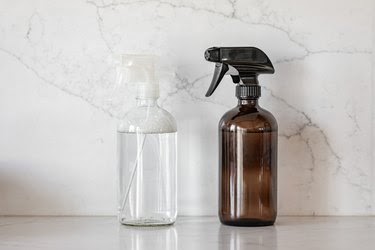Quck answer
Calcium build-up on faucets can be unsightly and affect water flow. To remove it, follow these steps:
1. Create a vinegar solution by mixing equal parts white vinegar and water.
2. Soak a cloth or paper towel in the solution.
3. Wrap the cloth around the affected area, making sure it is fully covered.
4. Let it sit for 1-2 hours to allow the vinegar to dissolve the calcium.
5. Remove the cloth and scrub the area gently with a toothbrush or scrub brush.
6. Rinse the faucet thoroughly with water.
7. Dry the faucet with a clean cloth to prevent water spots.
Regular cleaning and maintenance will help prevent future calcium build-up.
Calcium is a common element found in the earth’s crust and can dissolve into groundwater, eventually entering residential water supplies. Hard water, which contains high levels of calcium deposits, is a common issue, especially for those who get their water from wells. This often leads to calcium buildup on faucets, which can be difficult to remove.
Calcium deposits are essentially salts, and salts can be dissolved with acid. Any acid will work, as long as you allow enough time for it to work. Most households have acidic solutions in their kitchen cabinets or refrigerators.
If you have calcium buildup on your faucets and want to remove it, here is what you need to know.
Acids for Removing Calcium Deposits

Image Credit:
Stephen Paul for Hunker
You don’t need to buy strong acids like muriatic acid or sulfuric acid drain clog removers from the store. These acids can be dangerous, damage metal, and potentially worsen the situation. Instead, you can use safe acids that are commonly found in kitchens or may require a trip to the store. Here are some options:
- Vinegar (acetic acid) – Any type of vinegar will work, but 3 percent white distilled vinegar is the strongest. If you have 10 or 20 percent vinegar for killing weeds, that will be even more effective.
- Citrus juice (citric acid) – Lemon and lime juice are the best options, but you can also use orange or tomato juice if you are willing to wait longer.
- Milk (lactic acid) – Milk and dairy products contain lactic acid, which can dissolve calcium deposits. However, the concentration of lactic acid in milk is low, so it may not be the fastest option.
- Fizzy soft drinks (phosphoric acid) – Soft drinks that contain phosphoric acid (check the label) can dissolve calcium deposits. Cola is a viable option for cleaning faucets.
If you prefer a commercial product specifically designed for removing scale (another term for calcium deposits), you can find suitable options at hardware stores. One popular product, CLR, contains lactic acid as one of its main ingredients, so using milk wasn’t such a bad idea after all. However, the concentration of lactic acid in CLR is much higher than in milk.
Cleaning the Exterior of a Kitchen Faucet

Image Credit:
Stephen Paul for Hunker
When scale builds up on a faucet, it makes the metal appear dull. While it may seem like the dullness is permanent because you can’t simply wipe off the layer of calcium, it can actually be removed. The metal just needs to come into contact with any common household acid for a sufficient amount of time to dissolve the calcium salt causing the dullness.
The suggested approach is to saturate a paper towel with vinegar or your preferred acid, then wrap it around the faucet and leave it for a few hours. For better results, use a well-soaked rag. If dealing with stubborn scale, it may be necessary to keep the rag in contact with the metal for several hours. To prevent drying out, spray the rag with vinegar every hour.
This method also works with milder acids like milk or tomato juice, but it will take longer, possibly up to a day. It is important to re-soak the rag before it dries out. For efficient results, it is recommended to stick with vinegar as it is cost-effective, fast-acting, and does not leave behind any sticky residue.
To remove calcium deposits, you can create a scouring paste by mixing vinegar with flour, talc, laundry detergent, or borax. Avoid using baking soda as it is alkaline and will neutralize the acid, resulting in a foamy mixture without any cleaning power. Apply the paste using a toothbrush and scrub the affected areas, rinsing periodically to monitor progress. Keep in mind that if the scale is heavily built up, this method may take longer compared to the soaked rag strategy.
In cases where there is visible calcium buildup on the faucet and low water flow or stuck handles, it indicates deposits both inside and outside the faucet. You can disassemble the faucet and soak the valve, handles, and other parts (excluding rubber gaskets and O-rings) in vinegar or lemon juice overnight. This will restore them to their original condition.
If the faucet does not show visible scale on the outside but has low flow, a clogged aerator is likely causing the issue. Unscrew and remove the aerator, then try using the faucet. If the flow returns to normal, soak the aerator overnight in vinegar or lemon juice, and then reattach it to solve the problem.
Low flow from a faucet without a blocked aerator is typically caused by calcium buildup on the valve, which is more common in cartridge valves. These valves often have small holes that can easily become blocked. Clearing these holes is as simple as clearing the aerator. Disassemble the faucet, remove the cartridge, and soak it overnight in vinegar or lemon juice.
Dealing with Difficult Handles and Cartridges

Image Credit:
Hunker in Partnership With Acme Real Estate
If your faucet is heavily affected by scale build-up, you may encounter difficulties in removing the handle when disassembling the faucet to clean the valve. To address this issue, there is a specialized tool known as a handle puller, which is particularly effective for two-handled faucets. This tool, resembling a corkscrew, securely attaches to the faucet body and facilitates the removal of the handle by rotating it clockwise, provided that you have first removed the set screw.
Scale can also cause cartridges to become stuck inside the valve body. To resolve this problem, there is another tool called a cartridge puller. Faucet manufacturers produce these tools specifically for their faucets, so if you are unable to find one that is compatible with your faucet model, it is recommended to consult the manufacturer’s website for assistance.


